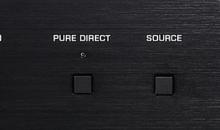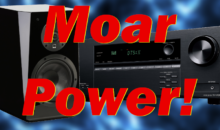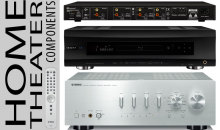Home Theater Receiver Buying Guide
While we’ve developed several helpful guides that cover various features and functions of AV receivers, it’s also good to know where to start when asking which AV receiver you should buy. With all of the options, how do you make a selection that’s best for you and your room? You start with the basics. Any audio receiver will get you something that makes sound, but choosing the right audio receiver means matching the right product to your room and particular needs. A good place to start is with the music or movies you listen to, the room you’re placing the gear into and the way in which you plan to utilize the system. After that, you can piece together the specifics and make a final decision.
So let’s start with the first item on the list.
Which AV Receiver You Should Buy Depends on the Music and Movies You Listen To
Behind this question lies the issue of “how” do you listen to music. It also takes into effect whether or not you have hopes of upgrading or using gigantic speakers and whether or not you prefer to achieve the 85dB SPL levels inherent in a movie theater-style listening environment (that’s really loud in a smaller room). When you analyze this, you’ll be closer to understanding which AV receiver you should buy.
In short, do you like your movies loud and clean? If so, then you will probably want a receiver that can give you the headroom you need for all of those explosive peaks in action scenes, or the delicate detail and dynamics of a symphonic score. An entry-level or near-entry-level receiver just doesn’t pack that much of a punch. And if you drive it too hard, you may end up distorting the sound and harming your speakers (see our article on How Much Amplifier Power Do I Need?)
Many times, after spending your hard-earned money on a new flat screen TV, you may be tempted to skimp on the surround receiver. Don’t. I’m almost certain that you bought that TV thinking it would give you something that at least approximated the movie-watching experience. It can, and it will—but only if you feed it enough power and supply the right equipment. As it pertains to your home audio receiver—well, that’s not the place you want to skimp.
What’s the Size and Type of the Room Where You’re Installing the Surround Receiver?
Believe it or not, a $300 receiver can’t put out enough power to drive your 2500 cubic foot living room to ear-bleeding levels. But it likely has enough power to put out the tunes in your home office or a bedroom. It will also do just fine if you find that loud music and bone-crunching movies aren’t exactly your style. If you want to fill a large room, however, you’re going to need to factor that into your estimates. Larger rooms require larger speakers…which (typically) require more amplification power. So if you want to crank it up you’re going to want a receiver that can put out enough juice to make it happen. Check out our article on Should I Upgrade My Audio Receiver? if you want more specific info on amplifier power requirements and suggestions on upgrading your speakers alongside a receiver.
Another thing to consider when considering which AV receiver you should buy is your room’s acoustics. A room with hardwood floors, terrazzo or other similar material will reflect more sound and render a louder, though possibly muddier, sound. Conversely, a room with lots of furniture, thicker carpet and lots of wall hangings may yield a more subdued sound and require more power to fill it up. The room is a significant contributor to the sound quality you’ll hear when you play back music and movies through your audio receiver to your speakers.
How Do You Want to Use the AV Receiver? What Are Your Goals?
This last bit when you choose which AV receiver you should buy is actually very important. Knowing how you intend to use the receiver will determine quite a bit. For example, if you want something that can handle two completely different rooms, then a discrete Zone 2 function is a must. That also bumps your price point up above that of an entry level product. If you want HDMI in that second room—from a discrete HDMI source at that—then you bump up even further.
Figuring out how many source components you intend to connect to the receiver will also steer you in the right direction. You also want to understand whether or not everything you currently use has HDMI outputs, or if you need to support legacy analogue audio outputs (like with an older DVD player or a Wii gaming system).
Finally, you want to know whether or not you need features like streaming network functions. Some receivers come with the ability to connect wirelessly to your iOS devices, through AirPlay. Others contain DLNA-compatibility, so you can stream audio from your PC. Still others go full-out and provide streaming video services from the likes of Netflix, YouTube and Crackle—to name a few. If you just want a basic AV receiver to play back music or movies from a Blu-ray player, then none of those extra features will make much difference. But if you want to enjoy all or some of the streaming media services that are available, you’ll want to investigate each manufacturer to see who supports the services to which you already subscribe.
So What Are the Next Steps?
Once you establish the basics, then you can move further into the technical decisions that follow. This includes going over the specific features like inputs, analogue video upconversion, amplifier power and any additional Zone requirements you may have. Remember, while receivers are gaining in features and functionality, this comes with a steeper learning curve. The good news is that manufacturers are starting to get the hint and are more frequently making it easier and easier to configure and use their products. How comfortable you are with these new features will also play into which AV receiver you should buy.
From here you may want to read our article on Should I Upgrade My Audio Receiver? That will take you to the next level in terms of which features might be key concerns for your needs in an audio receiver. And, as always, if you’ve got additional ideas about choosing the right AV receiver, drop us a line on Facebook or comment below and add to the discussion.







I have a denon 3312 powering my Martin Logan motion 40’s ,30,and FX’s rears and 2 10″ subs. They are are 4ohm and I have fried the fronts 2 ribbon tweeters at very high levels after only 3-5 min of listing . After replacing I set the denon to a max 0 db volume level to not do this again. Movies are more than loud enough at about -10db but occasionally i like to crank it up so would you recommend something like emotiva xpa-3 or 5 and use my preouts would there be much sound improvement and headroom or upgrade receiver or just deal with it as it’s still pretty loud at 0 db thanks
I always recommend upgrading for quality and to better match the capabilities of the system. It sounds like you’re already getting the volume you need, however a dedicated amp like an XPA-3 or XPA-5 would almost certainly provide a greater level of detail for music due to higher quality components used in the amplification chain (over the AVR 3312).
I have started moving into the great world of sight and sound. I just purchased an LG OLED, and added klipsch floor, center, subwoofer and their new elevation speakers. My question is what is the best way to configure this on a rcvr since it is a 5.1 but no surround sound back speakers?
Make sure during setup you tell it “None” for surrounds. It will do the rest!